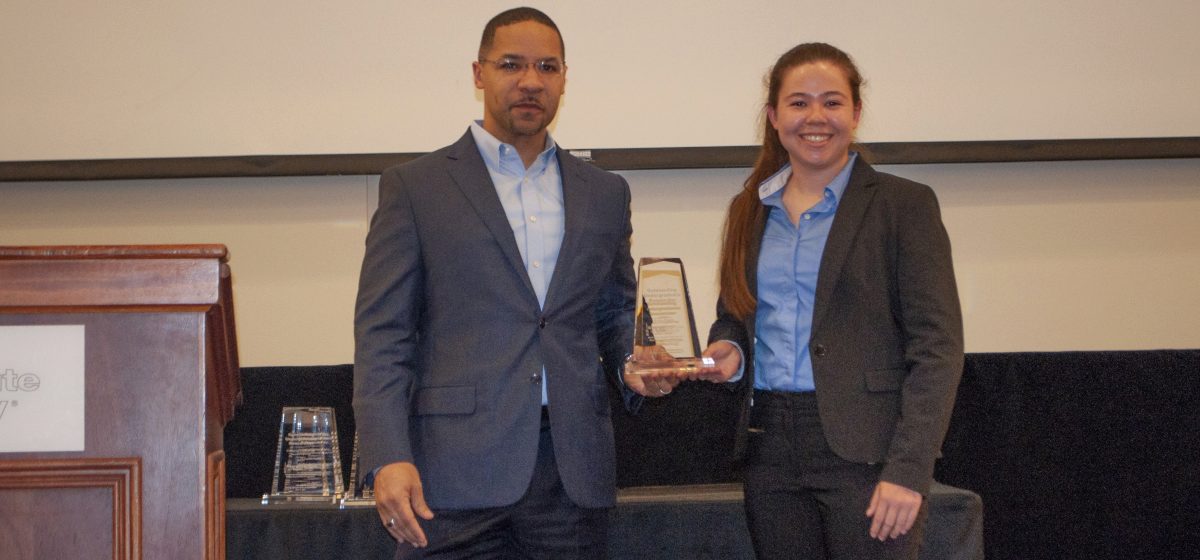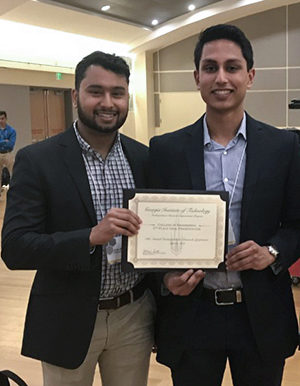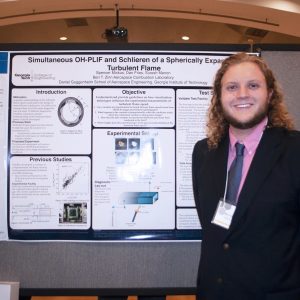
The Future Looks Luminous. Graduating senior Kelsey Pepper with her faculty mentor, Prof. Mitchell L.R. Walker, received the top award for her work, "Flame Visualization of Hall Thruster Propellant Distributors." | View the full photo album by visiting the AE Flickr page.
Georgia Tech's 14th Annual Undergraduate Research Symposium, held April 9, shined a light on some of the
 |
| Talking the Talk. "RL-10-3-3A Rocket Engine Turboprop System Level Design & Optimization Trades," by Anish Shenoy, left, and Utkarsh Pandey, was awarded second place for oral presentations. Read their abstract (pdf) |
hardest working researchers in the field. Graduating senior Kelsey Pepper was chosen to receive the Outstanding Undergraduate Researcher Award for Aerospace Engineering. Her classmates, Utkarsh Pandey and Anish Shenoy took home second place for their oral presentation of "RL-10-3-3A Rocket Engine Turboprop System Level Design & Optimization Trades."
In addition to the crystal trophy, Pepper received a $200 stipend for her work, "Flame Visualization of Hall Thruster Propellant Distributors," which she completed while working in the High Power Electric Propulsion Lab under the guidance of Prof. Mitchell L.R. Walker.
Walker praised the judges' decision, adding:
"Kelsey Pepper really embodies the concept of 'fearless engineer.' If you meet her on campus, she might be on her way to Delta where she'll use their facilities to lay up the fuselage for Georgia Tech's solar-powered car. If you keep talking to her, you'll find out she's going to Lockheed this summer to build fighter jets. When she comes back, she'll get right back to the lab where she'll be characterizing propellant distributors for rocket engines. And on top of all that, she's an excellent student. Great in class."
Pepper's work continues research begun by Walker in which the luminosity of flames coming from a propellant distributor is studied to ultimately determine the condition of the thruster's anode. Starting at an equivalency
ratio of one for propane and air, other gas ratios are explored to see other indicators of a problem," Pepper said.
"If you have different ratios, it could indicate a leak, a degraded or clogged anode, or another instability in the system," she said. "So we have this novel way of testing for uneven flow. What we do is we light the gas mixture coming from the anode and observe the luminosity of that flame around its entire circumference. If the luminosity of the flame is the same at every point along that circumference, we know we have completely uniform flow. If not, we start to look for problems."
 |
| Developing a Better Diagnostic. Spencer Mickus and his poster presentation, "Simultaneous OH-PLIF and Schlieren Measurements of Spherically Expanding Flame" Read the abstract (pdf) |
Pepper has been comparing the equivalency ratios of older, previously used anodes with brand new anodes, to see how performance changes over time.
"The visualization method used correlates the image intensity of a premixed flame at each azimuthal location to the relative flow density across the propellant distributor," she said.
Pepper will pick up her undergraduate degree in a few weeks and start graduate school in the AE School's Aerospace Systems Design Lab in the fall. In between, she'll return to Lockheed Martin's Fort Worth facility where she'll continue flight testing research she began as an intern last summer. This will be her third rotation at Lockheed Martin, and it might not be her last. Asked about what she plans to do after completing her master's, the Germantown, Tennessee native smiled coyly.
"Well, it's really nice to be in industry, and I've really enjoyed my work at Lockheed, so I can really see myself staying there," she said. "But I definitely see a Ph.D. in my future. Then I'll be 'Dr. Pepper.'"
Long hours in the lab haven't robbed her of a mischievous sense of humor.
 Up, up, and Away. "Verification and Test of CubeSat Electronic Subsystems Using Balloon Launch", a poster presentation produced by AE undergrads: (l to r) Megan Kim, Ebenezer Arunkumar, Cameron Hines, Athreya Gundamraj, and Radina Yanakieva. Read their abstract (pdf)
Up, up, and Away. "Verification and Test of CubeSat Electronic Subsystems Using Balloon Launch", a poster presentation produced by AE undergrads: (l to r) Megan Kim, Ebenezer Arunkumar, Cameron Hines, Athreya Gundamraj, and Radina Yanakieva. Read their abstract (pdf)